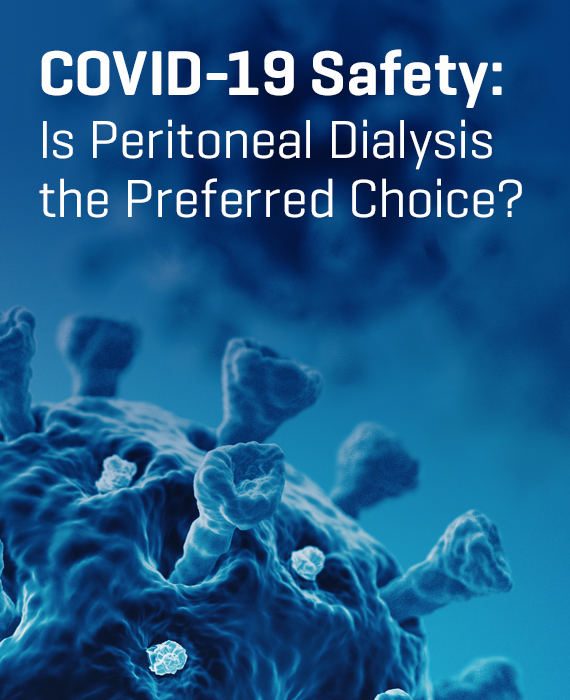A Place for Dialysis During COVID-19

Patients with kidney failure have immune dysfunction, which puts them among the highest-risk population for contracting viral infections, such as COVID-19. Supporting their ability to socially distance themselves during the pandemic is of great importance.
During this unprecedented time, we are working with healthcare professionals, local authorities and global nephrology societies to support rapid guidelines on how to keep patients socially distant regardless if they are starting dialysis, already on in-center hemodialysis (HD) or home peritoneal dialysis (PD).
![Female%20patient%20at%20bedside%20with%20Claria[12].jpg](/sites/g/files/ebysai1471/files/2020-05/Female%2520patient%2520at%2520bedside%2520with%2520Claria%5B12%5D.jpg)
Peritoneal Dialysis at Home
Consensus is that home dialysis should be prioritized for the 78% of kidney failure patients who are eligible for PD1 and need to practice social distancing during this time. PD enables patients to perform dialysis in the safety of their home, thus avoiding multiple trips to a dialysis clinic each week. With the addition of remote patient management (telehealth) capabilities, patients' care can be closely managed by their healthcare professionals without having to leave their home.
47
47 HD patients at Montefiore Medical Center, Bronx, NY diagnosed with COVID-19 with 8.5% mortality (as of March 31, 2020)2
16.09%
Up to 16.09% of HD patients and 12.12% of medical staff tested positive in Wuhan city dialysis centers3
61%
According to a survey of the Italian Society of Nephrology, compared to HD, SARS-CoV-2 positive cases were 61% less frequent among PD patients (1.38% vs 3.55%; p < 0.001)4

Expert Discussion: Is PD with Remote Patient Management a Preferred Choice During Covid-19?
Taking action to support access to chronic dialysis care in a safe environment is one of the most important things we can do for patients during the COVID-19 pandemic. Following the initial wave of COVID-19 infections that swept the globe, three leading dialysis experts provided their learnings from treating patients in the early days of the pandemic, and their perspectives on how remote patient management (telehealth) in combination with automated peritoneal dialysis at home can help keep patients safe now and in the future.
We invite you to listen to Professor Martin Wilkie, M.D., FRCP, Sheffield, UK, Professor Claudio Ronco, M.D., Nephrology at the University of Padova, Italy and Michelle Blaauw, Clinical Nurse Specialist, Great Ormond Street Hospital, London, discuss current thinking on:
- Safe delivery of dialysis during the pandemic
- Practical considerations from both patient and clinical staff perspectives
- The role of remote patient management
Resource Center

Acute Dialysis Using PD in the ICU
Continuous renal replacement therapy (CRRT) is the preferred mode of dialysis therapy for COVID-19 patients in the ICU. However, peritoneal dialysis (PD) is recognized as an acceptable alternative for the treatment of acute kidney injury in the ICU if access to CRRT machines is limited. Acute PD is a good option for patients as it is a slow, continuous therapy that does not require continuous monitoring from healthcare professionals. Once a PD cycler is set up on a patient, it can run for 24 hours without nursing intervention.
Starting COVID-19 patients on PD in the ICU can present challenges. These patients may need to remain in the prone position, and acute PD may not be able to be done in that situation. In addition, dialysis solution in the abdomen can affect respiratory function somewhat, which may be a problem for patients in severe respiratory distress. Also, the high concentration of lactate in the solution may be a problem if patients are in shock. Finally, if a patient is severely hyperkalemic or hypercatabolic, PD may not be appropriate since toxin removal is much slower with PD than with CRRT.
![173536_Baxter_Image_Bank_119383[19].jpg](/sites/g/files/ebysai1471/files/2020-05/173536_Baxter_Image_Bank_119383%5B19%5D.jpg)
Hemodialysis In-Center
As COVID-19 continues to challenge the medical community around the world, we are supporting healthcare professionals needs to access our hemodialysis machine training and handling in a virtual manner. Learn more about our hemodialysis resources.